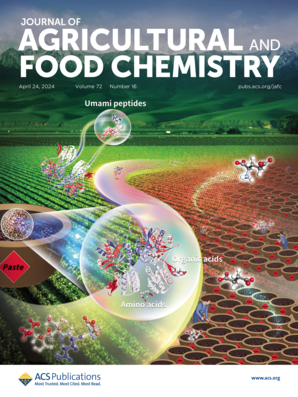Residue Patterns and Dietary Risk Assessment of Picarbutrazox and Its Metabolite TZ-1E in a Ginseng Planting System
IF 5.7
1区 农林科学
Q1 AGRICULTURE, MULTIDISCIPLINARY
引用次数: 0
Abstract
This study established a simple, sensitive, and rapid method for the residual analytical method of picarbutrazox and its metabolites (E)-picarbutrazox (TZ-1E) in ginseng plants, fresh ginseng, and dried ginseng. The samples were extracted and purified using an improved QuEChERS method and determined by HPLC-MS/MS. The linear relationship of the method was good (R2 ranging from 0.9935 to 0.9999), the limit of detection was 7.19 × 10−5 to 1.65 × 10−3 ng, the limit of quantitation was 0.01 mg/kg, the intra- and interday addition recovery rates ranged from 87.33 to 107.2%, and the relative standard deviation range was 0.58–8.21%. This method was applied to detect residual samples in the field. The results showed that the degradation of picarbutrazox in ginseng plants followed first-order kinetic equations; the R2 values were 0.9293 and 0.9430, and the half-lives (t1/2) were 8.24 and 11.5 d, respectively. It was an easily degradable pesticide (t1/2 < 30 d). The final residual levels of picarbutrazox in ginseng plants, fresh ginseng, and dried ginseng ranged from 0.0184 to 19.223 mg/kg. A dietary risk assessment was conducted based on the final residual levels of picarbutrazox in fresh and dried ginseng, and the results showed that the chronic exposure risk quotient values of both fresh and dried ginseng were less than 100% (0.1303% for both fresh and dried ginseng). This indicated that the dietary risk of using 10% picarbutrazox suspension concentrate in ginseng was very low and did not pose an unacceptable risk to public health. The results of this study can provide a basis for the development of maximum residue limit for picarbutrazox in ginseng.

picarbutrazole及其代谢物TZ-1E在人参种植系统中的残留模式及膳食风险评估
本研究建立了一种简便、灵敏、快速的人参植物、鲜人参和干人参中皮卡布唑及其代谢物(E)-皮卡布唑(TZ-1E)残留分析方法。样品采用改进的QuEChERS法提取纯化,HPLC-MS/MS测定。方法线性关系良好(R2为0.9935 ~ 0.9999),检出限为7.19 × 10−5 ~ 1.65 × 10−3 ng,定量限为0.01 mg/kg,日内和日间添加回收率为87.33 ~ 107.2%,相对标准偏差为0.58 ~ 8.21%。将该方法应用于野外残留样品的检测。结果表明:吡虫唑在人参中的降解符合一级动力学方程;R2分别为0.9293和0.9430,半衰期(t1/2)分别为8.24和11.5 d。它是一种易降解的农药(t1/2 <;人参植株、新鲜人参和干人参中吡虫唑的最终残留水平为0.0184 ~ 19.223 mg/kg。根据鲜人参和干人参中吡虫唑的最终残留水平进行膳食风险评估,结果表明,鲜人参和干人参的慢性暴露风险商值均小于100%(鲜人参和干人参的慢性暴露风险商值均为0.1303%)。这表明,在人参中使用10%吡虫唑悬浮液浓缩液的饮食风险非常低,不会对公众健康构成不可接受的风险。本研究结果可为枇杷灵在人参中最大残留限量的制定提供依据。
本文章由计算机程序翻译,如有差异,请以英文原文为准。
求助全文
约1分钟内获得全文
求助全文
来源期刊
CiteScore
9.90
自引率
8.20%
发文量
1375
审稿时长
2.3 months
期刊介绍:
The Journal of Agricultural and Food Chemistry publishes high-quality, cutting edge original research representing complete studies and research advances dealing with the chemistry and biochemistry of agriculture and food. The Journal also encourages papers with chemistry and/or biochemistry as a major component combined with biological/sensory/nutritional/toxicological evaluation related to agriculture and/or food.

 求助内容:
求助内容: 应助结果提醒方式:
应助结果提醒方式:


